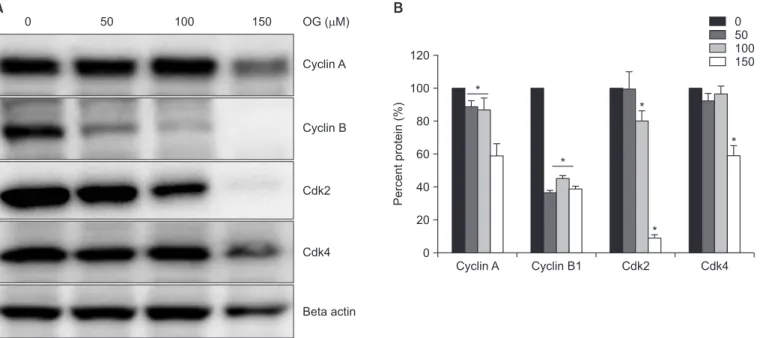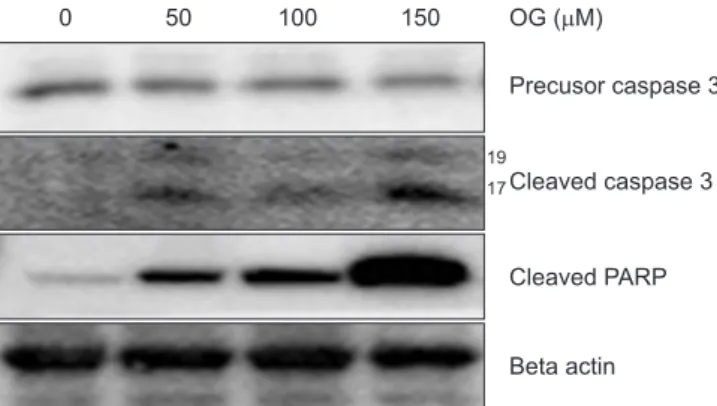Introduction Introduction
Oral cancer accounts for approximately 8% of all malignancy which ranges from the 6th to the 9th most popular cancer all over the world [1]. About 90% of oral cancer is squamous cell carcinoma (OSCC) developed in the mucosal membranes of mouth, tongue, floors of mouths, gums, and hard palates [2,3]. High-risk factors of OSCC include tobacco or/and alcohol consumption, micronutrient inadequacy, human papillomavi- rus infection and ultra-violet radiation exposure. Despite the therapeutic advances, the relapse incidence of OSCC is still 40 to 60% and the survival rate for longer than three years is only 30 to 50% after treatment [1,4].
Octyl gallate (OG) and other members of gallate family have been well-known for various biological activities such as He- licobacter pylori inhibition, neurodegeneration improvement
and tumorigenesis suppression [5]. Gallic acid and its ester derivatives were reported to have various therapeutic effects in anti-oxidation, anti-inflammation and anti-tumorigenesis [6,7]. Particularly, OG showed characteristic anticancer ef- fects on various types of cancers with various molecular mechanisms. In human breast cancer cell lines of MCF-7 and MDA-MB-231, OG and gallic acid, isolated from Terminalia bellarica, inhibited cell cycle progression and induced apopto- sis by downregulating positive cell cycle regulators of Cyclins and Cdks and upregulating negative regulators such as p21 and p27 [8]. In murine melanoma cell line, OG promoted oxi- dative stress and mitochondrial dysfunction to increase pro- apoptotic protein Bax while decreasing antiapoptotic protein Bcl-2, leading to caspase 3 activation and cell death [9]. From this perspective, we were motivated to investigate the OG’s effects on OSCC and its underlying molecular mechanism. In Int J Oral Biol 45:218-224, 2020
pISSN: 1226-7155 • eISSN: 2287-6618 https://doi.org/10.11620/IJOB.2020.45.4.218
Antitumor effects of octyl gallate on hypopharyngeal carcinoma cells
Trang NTK and Hoon Yoo*
Department of Pharmacology and Dental Therapeutics, College of Dentistry, Chosun University, Gwangju 61452, Republic of Korea
The antitumor effects of octyl gallate (OG) were investigated on FaDu human hypopharyngeal squamous carcinoma cells. At various concentrations, OG inhibited the proliferation of FaDu cells by suppressing cell cycle regulators and induced apoptosis by activating caspase 3 and its downstream poly (ADP-ribose) polymerase, thereby damaging DNA. Immunoblotting demonstrated that OG significantly suppressed the expression of integrin family proteins (integrin α4, αv, β3, β4), hindering cell adhesion. The reduced expression of integrins subsequently mediated the mitogen- activated protein kinase signaling pathway to stimulate the activation of extracellular signal-regulated kinases and c-jun N-terminal kinases, leading to apoptosis. Thus, OG demonstrated antitumor activity on hypopharyngeal squamous carcinoma cells by suppressing cell proliferation and inducing apoptosis.
Keywords: Pharyngeal squamous cell carcinoma, Octyl gallate, Apoptosis, Mitogen-activated protein kinase signaling pathway, Integrins
Received August 15, 2020; Revised December 15, 2020; Accepted December 16, 2020
*Correspondence to: Hoon Yoo, E-mail: hoon_yoo@chosun.ac.kr. https://orcid.org/0000-0002-9249-1446 Copyright © The Korean Academy of Oral Biology
CC


